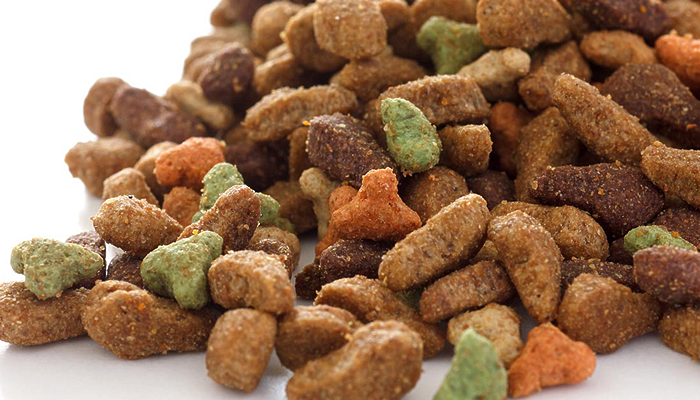We all know the positive side of kibble, dry pet food: it is amazingly convenient and has a long storage life. Many dry foods have a shelf life of years. We also know these foods are balanced to meet a certain level of nutrition. But there are definitely downsides to dry dog and cat food.
The recall issued one week ago for Beneful, a national best selling food, is prime example of why kibble is potentially unhealthy. Dry dog and cat food is made in enormous size batches. Train car loads of individual ingredients are delivered to the pet food plants. Imagine for a moment you are standing next to a train car filled with corn gluten, a commonly used source of protein in pet food. The gluten is the byproduct after the corn is processed for human consumption. How long do you imagine that gluten sat before it was loaded into the train car? How long did it take for that train car to travel to the pet food factory? What about rodents and insects that like to eat grain? How do we keep those out of the train car? You are correct, a toxic chemical is spread on the top of the feed ingredients in the train car to keep out the pests. Reportedly, the toxin breaks down before being mixed into the giant 5000 pound feed mixing bowl at the pet food manufacturing plant.
Which brings up another reason to be suspicious of dry pet food: the only way you can truly know what is really in there as if you put it in the bowl yourself (in other words, did that toxic chemical truly breakdown before entering your pet’s food?) As in you went to the store and individually picked out each ingredient. Because truthfully, if we go to the store and buy ourselves a box of crackers, do we really know exactly what’s in that cracker? No. We trust it to be what it says it is. But have you ever seen low calorie bread or crackers? One of the ingredients used and low calorie bread goods is called powdered cellulose. (It’s the same ingredient that’s put in some dry dog and cat food.) Unless you did the research, most consumers would not know that is a fancy word for sawdust!
Let’s look at a few other hazards of kibble that I have encountered in my patients over the last couple of years. For many dogs and cats, it is highly processed food and is very hard to digest. For some pets it creates stomach ulcers. For others, it can lead to intestinal bleeding. For many cats, dry food eventually contributes to kidney disease and shortened lives. For some, the pretty colors leads to allergic reactions. For others, the ingredients can cause hot spots and ear infections.
Items listed above are just the tip of the iceberg. We will chat in the next few weeks about similar subject.
I wish you and your pets the greatest health and longest lives. It is my goal to give you tools to make their lives better. Good nutrition is a big part of everything we do. For this reason Susan Thixton and I have updated our cookbook, Dinner PAWSible — you can order it here.


I hate giving my dogs dog food. I would say now that half of what they eat is cooked by me and the other half is what I think to be premium dog food. The only reason I use it is because I have 3 large labs and its hard to cook enough food to not give them it. I use Orijen and Arcana foods. Same company, they sell these 2 names. They are said to be premium foods. They dont contain grains or gluten. The ingredients are listed on the website store I order it from and I do read labels. Dr. Cathy, can you tell me if this food is bad for them because if it will still get them sick I will not use it anymore. As it is now, I try to give them as much home cooked as I can.
Great question! And I love all of the steps you are taking to feed your dogs well. Both foods have an excellent reputation and to date have not had any company problems. And I bet your dogs love when you cook for them. Good for you!
ORIJEN AND ACANA ARE IN BIG TROUBLE-MAJOR LAW SUITS -CLASS ACTION. I WONDER IF PURINA PAYS PEOPLE TO SUE THEM, SO THEY CAN KILL ALL OF THE COMPETITION THE EASY WAY-BUY THEM OUT.
ORIJEN AND ACANA ARE BEING SUED BY 4 STAGES IN CLASS ACTION SUITS-HEAVY METALS, AS WITH WELLNESS. THE CLASS ACTION LAW SUITS ARE ON THE POISONED PETS SITE AND THE TRUTH ABOUT PET FOOD SIGHTS. DAMN SHAME-I LOVED THAT FOOD.